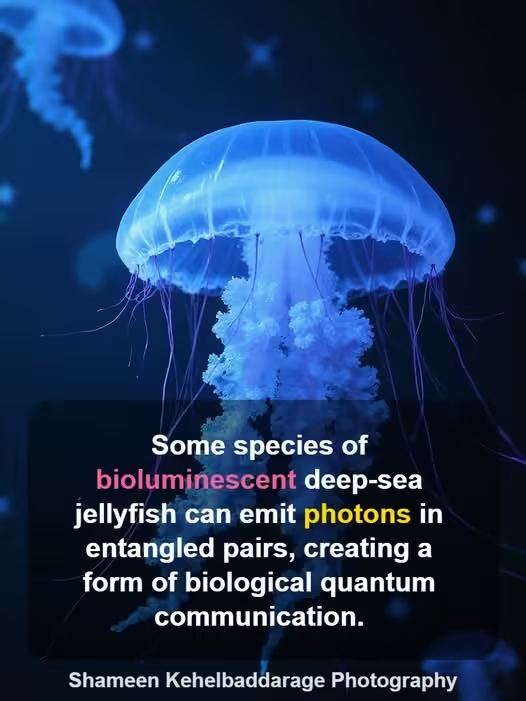
Quantum Lights of the Deep: The Astonishing Bioluminescence of Deep-Sea Jellyfish
Beneath the crushing weight of Earth’s oceans lies a realm so dark and alien it may as well be another planet. Down in the hadal zones—depths beyond 6,000 meters—life adapts in extraordinary ways. Here, where sunlight never reaches and pressure is immense, some species of jellyfish illuminate the darkness with radiant, pulsing lights. This bioluminescence, long thought to serve purposes such as predator deterrence or prey attraction, is now suspected of harboring a far more profound function—primitive quantum communication.
Yes, you read that correctly. A small group of researchers theorize that certain deep-sea jellyfish may be utilizing quantum entanglement, a phenomenon once thought exclusive to physics laboratories and theoretical constructs, as part of their biological processes. If true, this discovery could revolutionize not only our understanding of jellyfish and marine biology but challenge the very foundation of how information and communication operate in the living world.
Beyond Bioluminescence: A Deeper Light
Bioluminescence in jellyfish is not a new discovery. It’s a well-documented phenomenon wherein specialized cells known as photocytes or luciferin-based molecules produce light through biochemical reactions. These glowing displays serve many functions—startling predators, luring prey, attracting mates, or even camouflaging the jellyfish by blending with the faint light above.
But a recent anomaly caught the attention of physicists and biologists working together in a joint deep-sea exploration effort. During high-resolution optical imaging and photon behavior analysis, a group of deep-dwelling jellyfish began emitting pairs of photons with entangled quantum properties—meaning the state of one photon directly influenced the other, regardless of the distance separating them.
These photons didn’t behave like ordinary light particles. Instead, they maintained a correlated behavior pattern that suggested something more was going on than just glow-in-the-dark survival tactics.
What Is Quantum Entanglement?
To grasp the weight of this potential discovery, we must briefly delve into the concept of quantum entanglement. In quantum physics, when two particles become entangled, their states are linked in such a way that changing the state of one instantly changes the state of the other—no matter how far apart they are.
This instantaneous link puzzled Einstein, who famously referred to it as “spooky action at a distance.” Entanglement has been observed under tightly controlled laboratory conditions and forms the backbone of emerging quantum computing and communication systems.
But in nature? That’s a different story.
Living Systems and Quantum Mechanics
For decades, biology and quantum physics existed in separate scientific silos. But in recent years, researchers have found increasing evidence that quantum effects may influence biological systems. Birds, for example, may use quantum entanglement in their navigation systems. Plants might use quantum coherence to transfer energy efficiently during photosynthesis.
The idea that life could tap into quantum phenomena is no longer science fiction—it’s emerging science. Now, if jellyfish truly exploit quantum entanglement in their light-emitting organs, they could represent one of the most sophisticated natural examples of quantum biology in action.
Observations from the Deep
During the study, scientists used ultra-sensitive photodetectors capable of analyzing individual photons. When examining the light pulses from several species of jellyfish found near hydrothermal vents in the Mariana Trench, they noticed repeated instances where photon pairs shared polarization states in statistically significant ways. These weren’t just random emissions—these were entangled photons, behaving in a way that suggested coordination or purpose.
Furthermore, the entangled photons seemed to propagate only a limited distance—just enough to be detected by another jellyfish nearby. This raises the provocative question: Could jellyfish be using these emissions to communicate in an advanced, light-based form?
Communication Without Words—or Wires
If jellyfish are indeed using entangled photons for communication, it wouldn’t resemble language as we know it. There would be no Morse code, no sonar pulses, no acoustic frequencies. Instead, information could be encoded in quantum states, such as spin, phase, or polarization—transferred instantly between creatures sharing the same entangled field.
Even though the distances involved would be small—probably just a few meters—it could be enough for schooling behavior, coordinated escape responses, or reproductive signaling in total darkness. This form of communication would be instantaneous, silent, undetectable to predators, and potentially unjammable by environmental noise.
A New Field Emerges: Quantum Marine Ecology?
Though still in the realm of emerging theory, this idea is gaining interest among interdisciplinary teams. If confirmed, it could give rise to an entirely new branch of science—quantum marine ecology. This field would explore how marine organisms interact not just through chemistry or mechanics, but through quantum phenomena once reserved for subatomic particles.
From a technological perspective, the implications are equally staggering. Understanding how a simple organism like a jellyfish can stabilize and utilize entangled photons in open seawater could lead to breakthroughs in underwater quantum communication—a notoriously difficult challenge for engineers trying to build secure, efficient submarine communication systems.
Skepticism and the Scientific Road Ahead
Naturally, this theory faces intense scrutiny. Detecting entanglement is no easy task, especially in the murky, turbulent waters of the deep sea. There’s always the risk that the observed photon behavior could be due to instrumental artifacts, thermal noise, or biological randomness.
Further, even if entanglement exists in the jellyfish’s light output, proving that it serves a purpose—especially one as advanced as communication—requires much more data. Experiments are underway to replicate these emissions in lab-controlled jellyfish tissue, and compare them with manmade entangled photon systems.
Still, even the possibility that such a mechanism could exist in nature is enough to excite the global scientific community.
The Future of Bioluminescent Intelligence
If this theory bears out, it may dramatically shift how we perceive intelligence in the natural world. Intelligence doesn’t always require a brain, neurons, or cognition. It may emerge from patterned behavior, evolutionary design, or even quantum feedback systems.
These jellyfish—often seen as simple, brainless drifters—might hold secrets about the intersections of light, life, and quantum mechanics. In doing so, they challenge our understanding of what it means to “communicate,” and who, or what, gets to be considered intelligent.
Final Thoughts: Strange Light in Stranger Waters
The deep ocean has always hidden mysteries, but if jellyfish truly use quantum light to “speak” across the abyss, we may be witnessing one of the most mind-bending discoveries in biology. This strange light is more than a glow—it may be a message, flickering in quantum whispers from one of Earth’s most alien realms.
As we shine brighter lights into these depths, it’s not just darkness we’re dispelling—it’s ignorance. And in its place, we may discover a form of communication older, quieter, and more profound than anything we’ve ever imagined.


